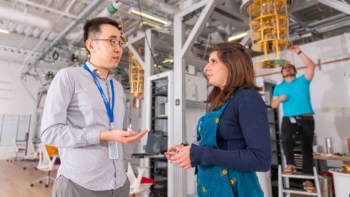Hamish Johnston reviews Quantum Computing: How It Works and Why It Could Change the World by Amit Katwala, WIRED

Quantum science and technology is a hot ticket today, with governments, major tech companies and financiers around the world pouring money into research and development. As a result, the need to understand the basics of things like quantum computing and quantum cryptography goes well beyond the academic community. The problem, however, is that the concepts underlying these technologies can be fiendish to understand – even for physicists working in fields other than quantum information.
As a result, there is a growing need for guides to the quantum technology aimed at the layperson who might be interested in investing in a quantum technology company or a businessperson who might want to use the products or services of such a company.
That is where Quantum Computing: How it Works, and Why it Could Change the World by Amit Katwala fits the bill. Katwala is not a physicist or computer scientist – he studied experimental psychology at the University of Oxford – and he writes, “This book is intended to be a primer to quantum computing for people who don’t have a background in maths or physics”.
As I read Katwala’s book I imagined myself to be that financier or businessperson and asked: does this book elucidate the basics of quantum science and present a good vision of the myriad technological challenges facing developers of quantum technologies? Despite the book being only about 150 pages, Katwala has succeeded admirably.
He gets off to a good start by providing the reader with enough information to have a basic understanding of the concepts of quantum computing without the danger of having them lose the plot with too much information. The book begins with the standard explanation that a quantum bit (qubit) of information can be in a superposition of two states at one time. Then he pushes his explanation a bit further, writing that the wave nature of quantum mechanics is harnessed by a quantum processor to choreograph the interference between connected qubits such that the wrong answers to a problem cancel each other out and the correct answers reinforce each other. It is this dance that allows quantum computers to solve some problems much more efficiently than conventional, or “classical” computers.
Success is not guaranteed – a very useful bit of information for a potential investor
I think this description is enough for the reader to appreciate the key challenge facing developers today – how to keep that choreographed dance of qubits going long enough to do a useful calculation. Katwala covers this problem in his second chapter, “Building the impossible”. He looks at the challenges of keeping the quantum dance going despite the destructive effects of noise, heat and other environmental factors. This allows him to introduce the very important idea that quantum computing has just entered the noisy intermediate scale quantum (NISQ) era. NISQ describes the nascent quantum processors with 50 or so qubits currently being operated by the likes of Google and IBM.
“It’s all part of a delicate balancing act,” writes Katwala. “Each computation is a frantic race to perform as many operations as possible before a qubit ‘decoheres’ out of superposition.” He then explains that connecting more qubits together to make larger quantum processors worsens this decoherence – thereby identifying the central dilemma facing anyone who wants to build a commercial quantum computer that can solve practical problems and thus make its inventors money. While this challenge is not necessarily insurmountable, Katwala makes it clear that success is not guaranteed – a very useful bit of information for a potential investor.
He explains that most cutting-edge quantum processors today – including those developed by Google and IBM – use tens of superconducting qubits that are coupled using microwaves. Indeed, it is these devices that have been the first to demonstrate “quantum advantage”, whereby a quantum computer can solve a problem in a much shorter time than a supercomputer. Katwala devotes several pages to describing these superconducting processors but makes it clear that there are problems related to coupling, cooling and controlling larger numbers of superconducting qubits.
Qubit numbers are not everything and potential investors in new quantum computing technologies might want to consider a figure of merit called “quantum volume”
The book also points out that qubit numbers are not everything and that potential investors in new quantum computing technologies might want to consider a figure of merit called “quantum volume”, which is a measure of how many useful calculations a processor can do before it succumbs to decoherence.
Katwala explains that decoherence can be addressed in two ways. One is to build better qubits and the other is to use error-correction schemes. The problem with the latter is that it takes many additional qubits to run error correction. He quotes an expert who says that tens of thousands of qubits could be needed to create an error-corrected system with a few hundred “logical” qubits.
Indeed, an investor today might want to eschew conventional superconducting qubits as Microsoft has done. Instead, as Katwala explains, the tech giant is trying to develop topological qubits, which should be much more robust than superconducting qubits – at least in principle. The book also looks at a recent breakthrough in using trapped ions as qubits, making it clear that the winning technology for quantum computing is far from certain – if there ever will be a winner.
Shifting from hardware to software halfway through the book, Katwala presents an overview of the types of problems that are amenable to quantum advantage – and which are not. The upshot is that not all difficult problems are easier to solve on a quantum computer than on a classical processor – so quantum computing is by no means a panacea.
An example of where quantum computers could be particularly useful is Shor’s algorithm, which a quantum computer could use to find the factors of a large number in a much shorter time than it would take a classical computer. Factoring numbers plays an important role in current cryptography techniques to ensure the secure exchange of information – and being able to factor large numbers would be a big advantage to someone trying to crack cryptographic systems. So a practical quantum computer capable of running Shor’s algorithm would be a boon to spies and criminals alike – and would also lead to a shake-up in how confidential information is exchanged.
Another example of where a quantum computer can outshine a classical processor is Grover’s algorithm, which can be used to search databases. Some optimization problems are also amenable to quantum advantage – tasks such as real-time traffic routing and simulating financial markets, which could both benefit from real-time predictions. So, there are several ways that a practical quantum computer could make someone some money.
As well as having the potential to crack cryptography codes, Katwala explains how quantum technology could be used to create secure systems to exchange information. Indeed, practical quantum cryptography systems already exist and are being used commercially.
The book links today’s intense interest in quantum cryptography – particularly in China – with the 2013 release of US classified documents by Edward Snowden. This huge leak revealed the extent to which the US National Security Agency (NSA) had been spying on foreign governments and even American citizens. Katwala claims that the NSA’s capabilities so terrified the Chinese government that it has spent vast amounts of money on developing quantum technologies to keep its secrets secure. This includes the launch of a satellite called Micius, which is an important early step towards the creation of a secure quantum internet. Indeed, if a country could develop a quantum computer capable of cracking cryptography systems, while being able to use quantum systems to secure its own information it would be in an enviable position.

Putting quantum noise to work
Katwala devotes an entire chapter to how quantum computers are perfectly suited for simulating natural systems – particularly systems such as molecules that are themselves governed by quantum mechanics. The commercial applications of this could be limitless – from designing new drugs to building better batteries. Perhaps this is where a budding quantum investor should be focusing today.
So what is next for the future of quantum computing? Katwala says we should expect much work to be done on improving quantum hardware, hopefully pushing it beyond the NISQ era. He also identifies the need for a much more friendly interface between quantum computers and their users. This will require a move away from the current machine-language approach to higher-level languages such as Q#, which is being developed by Microsoft.
Katwala’s guide to quantum computing is upbeat, but he does end on a cautionary note, pointing out that today, the development of quantum technologies is not at the point where it is a matter of companies competing against each other to create the best quantum processors. Instead, he quotes a quantum researcher at Google who says, “It’s our technology against nature.”
- 2021 WIRED Guide, Random House Business £8.99pb 160pp



